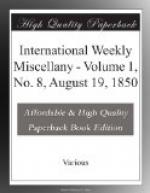* * * * *
M. FLANDIN, an eminent dilettante and designer attached to the French embassy in Persia, has published in the last number of the Revue des Deux Mondes an interesting memoir of the ruins of Persepolis, under the title of “An Archaiological Journey in Persia.” On his route to the ruins he witnessed melancholy evidence, in the condition of the surface and population, of the improvidence and noxiousness of Oriental despotism. He tells us that the remains of the magnificent palace of Darius are dispersed over an immense plateau, which looks down on the plain of Merdacht. “Assuredly, they are not much, compared with what they must have been in the time of the last Prince who sheltered himself under the royal roof. Nevertheless, what is now found of them still excites astonishment, and inspires a sentiment of religious admiration for a civilization that could create monuments so stupendous; impress on them a character of so much grandeur; and give them a solidity which has prereserved the most important parts until our days, through twenty-two centuries, and all the revolutions by which Persia has been devastated. The pillars are covered with European names deeply cut in the stone. English are far the most numerous. Very few, however, are of celebrated travelers. We observed, with satisfaction, those of Sir John Malcolm and Mr. Morier, both of whom have so successfully treated Persian subjects.”
* * * * *
EMILE GIRARDIN states in his journal that he paid for the eleven volumes of Chateaubriand’s Posthumous Memoirs as they appeared, piecemeal, in his feuilleton, the sum of ninety-seven thousand one hundred and eight francs. They occupied a hundred and ninety-two feuilletons, and cost him thus more than a franc a line. Alfred de Broglie has made these memoirs the test of a paper entitled “Memoirs de Chateaubriand, a Moral and Political Study,” in the Revue des Deux Mondes. It is a severe analysis of the book and the man. He concludes that Chateaubriand




